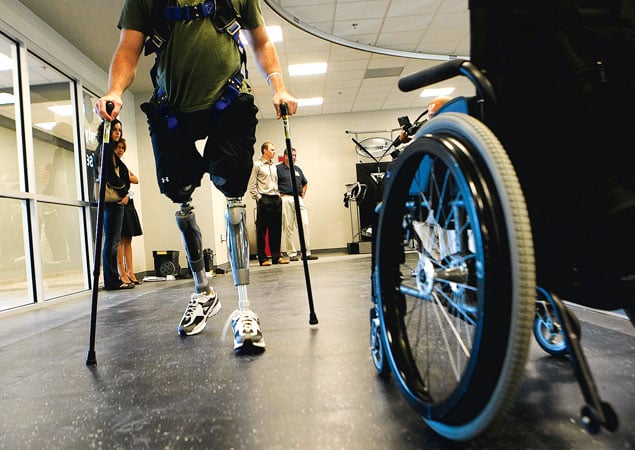I was outside with Cosmo on a grassy hill behind Walter Reed’s amputee clinic. He was up high on his C-Legs, and I had a belt around his waist to hold onto him. Cosmo was a lot bigger than me, so if he fell, I’d only be able to slow his descent. He stopped to rest, leaning on his canes, sweat running down his face. “I’m never going to be able to go hiking again, am I?” he said.
“It would be really difficult,” I said. We weren’t in Yellowstone. We were in DC, walking down a sloping gravel parking lot.
“I thought that when I got my C-Legs I’d be able to do all those things.”
I’m not a big fan of never. But I didn’t say that. Instead I admitted, “Nothing is as good as the real thing.”
Most people think the new computerized legs are bionic—strap them on and they’ll walk for you. I’m sure a technology-captivated guy like Cosmo had those hopes. His only outlet, besides physical therapy, was video games, where, in a computer-simulated environment, he could truly be bionic.
But in the real world, if you’re a bilateral above-knee amputee—meaning both legs have been amputated at the thigh—it takes a lot of strength to balance your nubs on artificial knees and ankles and propel yourself along. There are bilateral above-knee amputees who eventually walk, even run. But another goal eludes them: to be back at the level they were. And most of them have the advantage of being small and slight. For someone with a heavy, muscular torso, it’s harder.
The day we went outside was the day I lost Cosmo. In the clinic, he’d walked smoothly on his C-Legs. He’d gotten the knees to bend and hadn’t caught his feet on the floor. But outside, there are uneven sidewalks, crowds and cars and runaway dogs. Why expend all that energy when you can zip by in a wheelchair?
Cosmo stopped doing physical therapy. He’d pop by once a week to keep from getting in trouble with his case manager. I let him get away with it. “Get caught up working on your Nobel-winning research?” I asked when he showed up one week. Cosmo laughed. He looked tired. “What time did you get to bed?” I asked. He went to sleep around the time I woke up for work. “Xbox?” I said.
Cosmo could have gotten to a level where he’d be a “community ambulator” (someone who could walk around his community), but it would have required a lot of time and work. And it wasn’t his goal. It was mine. I wanted Cosmo out in the world.
Instead, he retreated into an online world where he was whole, where he could link up, via Xbox, with his old Army buddies and be a soldier again.
He went home for a month on pass. I fretted: Was he stuck in his house all alone, lost to a virtual life? But Cosmo came back exuberant. He’d been on trips, including camping in the Rockies, found a wheelchair-accessible cabin, gone on a helicopter ride.
We talked again about walking. Cosmo wasn’t interested. He was okay with his life as it was.
The highest compliment my coworkers and I can give one another is to say how well someone’s patient is walking. It’s a thrill. And if a patient doesn’t walk well, it’s almost always because he’s “difficult.” Doesn’t listen to what you say. Doesn’t do the work.
But Cosmo wasn’t always difficult. In many ways he was the patient I identified with the most. We just didn’t have the same goals. And even though it wasn’t the result I was aiming for, I’m really proud of him.
Adapted from Run, Don’t Walk: The Curious and Chaotic Life of a Physical Therapist Inside Walter Reed Army Medical Center, copyright © 2014 by Adele Levine. By arrangement with Avery, a member of Penguin Group (USA).
This article appears in the May 2014 issue of Washingtonian.



















